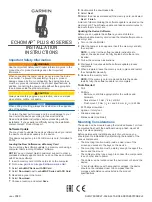
Townsend Labs Sphere L22 Precision Microphone System Guide
Stereo Recording
50
Two Microphones
Using two mics lets you employ a wider range of stereo techniques. In general, you can use the same stereo
techniques you have used before, although there are some advanced features, such as
OFF-AXIS
CORRECTION
™, which open up new options.
With two Sphere mics you can even go beyond stereo to quad or 5.0 surround. A nice way to achieve this is to
use an XY mic configuration, with each mic positioned coincidently 90° off-axis from the other. From this you
can capture front left and rear right outputs from one mic and the front right and rear left outputs from the
other mic. Cardioid patterns are typically used for all mics in this application.
To create a center channel for 5.0 surround, the simplest option is to just sum the left and right virtual mic
outputs. This creates a center-panned virtual cardioid mic (assuming left and right outputs are cardioid). A
potentially better option is to sum the raw unprocessed outputs of both mics and send them to a stereo bus
with another Sphere plug-in. This lets the user set the center channel polar pattern independently. Setting the
pattern to super- or hypercardioid will produce better separation of the center from the left and right channels.
Since there are many possibilities, experiment to figure out what sounds best for your application.
Off-Axis Correction
Since cardioid mics lose directivity at low frequencies, they become omnidirectional and thus center panned in
the bass region, which blurs the stereo field.
Consider a stereo recording of a double bass, where the low frequency fundamentals will be perceived more
towards the center than the high frequency harmonics. Instead of occupying one point in the stereo field, this
single instrument will be spread out.
This change in polar pattern also depends on distance to the source, which is due to the well known proximity
effect. In fact, at low frequencies it is only possible to maintain a cardioid polar pattern at one specific distance
from the source (see
Off-Axis Correction
on page 21 for more information). Because of this, the
OFF-AXIS
CORRECTION
feature has two distance controls, which tell the algorithm how far away the mic is from the
sources. The first control is
ON-AXIS DISTANCE
, which specifies the distance of the on-axis source material
from the mic. The second control is
OFF-AXIS DISTANCE
, which specifies the distance of the off-axis source
material from the mic.
Fortunately, these controls do not need to be set exactly, and can be dialed in by ear. If there are multiple
sources at multiple distances, then just use an average distance, or simply go with what sounds best.
OFF-AXIS CORRECTION
can also be important for mid-side and other stereo and surround configurations that
use heterogeneous mic configurations. For example, with mid-side, the mid channel is either a cardioid or
omni mic and the side channel is a figure-8 mic. But practically speaking, the figure-8 mics always have a
different frequency response than omni and cardioid mics, so in effect the mid-side encoding will have
frequency dependent errors in the response. To some degree this is unavoidable, but with
OFF-AXIS
CORRECTION
you can correct a lot of the differences in frequency and polar response resulting in a better mid-
side recording.
OFF-AXIS CORRECTION
can be particularly important for surround applications where there are a lot of
overlapping polar patterns.





































